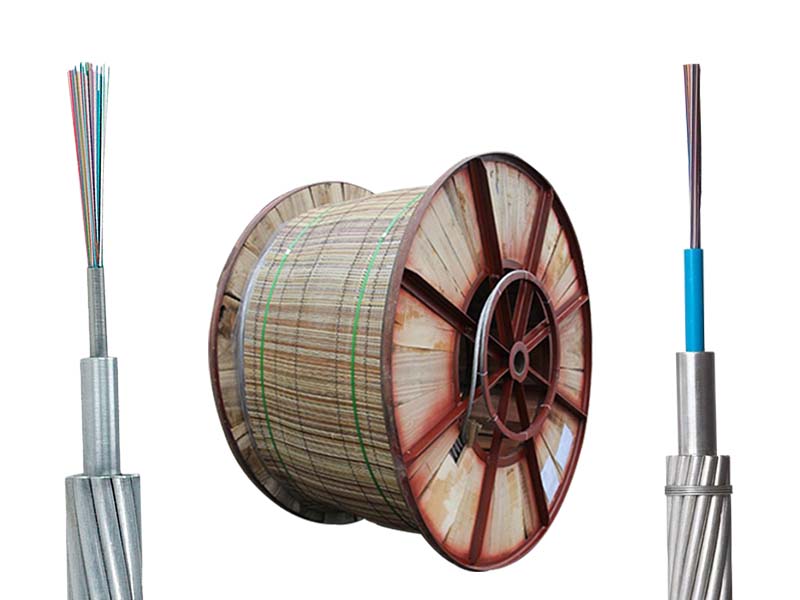
The optical fiber is located in a single PBT plastic loose tube,covered with seamless aluminum tubes.
The aluminum tube is twisted with 1-2 layers of single wire, which can be all aluminum clad steel wire or a mixture of aluminum clad steel wire and aluminum alloy wire.
2. Structural characteristics of OPGW optical cable
The structure of OPGW includes optical fiber unit structure and ground wire unit.
(I) Optical fiber unit and its structure
Under normal operation and installation, a reasonable optical fiber unit structure should minimize the stress and attenuation of the optical cable core. Therefore, the design of the optical fiber unit structure needs to consider the necessary mechanical protection structure to prevent the optical cable core from being squeezed, the appropriate excess length of the core to reduce the stress on the core, and take measures to achieve moisture-proof and heat-resistant purposes.
From the different tightness of the optical cable core arrangement in the optical fiber unit structure, it can be divided into a buffer tight sleeve structure and a loose sleeve structure.
1. Buffer tight sleeve structure
Basic theoretical basis: The fiber core bundle of the tight sleeve optical cable can only be broken when it is elongated by 2%. However, the maximum elongation of the bare ground wire in actual operation is only a few thousandths. Therefore, the allowable elongation of the optical cable core is much greater than the actual elongation of the ground wire, and the optical attenuation of the core can meet the engineering requirements. The most typical tight sleeve structure is an aluminum skeleton with multiple straight grooves or spiral grooves in the longitudinal direction. The grooves are used for placing optical fiber units. The typical structure is shown in Figure 1.
Structural features: The diameter of OPGW is relatively small, thereby reducing the wind load and ice load applied to the line tower; it provides protection for the optical fiber and increases the ability to resist bending; because it has a metal separation positioning groove, it has high anti-extrusion ability. Therefore, this type of OPGW has a strong ability to resist external loads and is suitable for projects with harsh conditions.
2. Loose tube structure
Basic theoretical basis: The fiber core of the optical cable placed in the protective tube of different materials is handled by adjusting the density of the filler or different structural forms to deal with the excess length of the optical fiber; at the same time, the actual length of the fiber core in the OPGW is greater than the length of the ground wire under stress, so the fiber core can be free of stress or very small stress. The typical structure is shown in Figure 2.
The loose tube structure OPGW is divided into central fiber type, layer twisted type and loose tube skeleton structure.
Characteristics of the central fiber loose tube structure: There are many means to protect the optical cable core, but the cable diameter is large and the coil length is short.
Characteristics of the layer twisted loose tube structure: The appearance is similar to the ordinary ground wire, which is easy to be accepted by the operation department (currently more used in Guangdong Province), and the coil length is long, which is conducive to reducing the loss of the optical fiber joint, but the manufacturing process and fiber core quality requirements are higher, and the means of protecting the optical fiber are slightly less. Characteristics of the loose tube skeleton structure: The ability to resist lateral pressure is comparable to that of the tight tube structure, but due to structural limitations, it can only accommodate up to 48 optical fibers, and cannot be used in projects with more optical fibers (currently rarely used in projects).
The above is a comprehensive comparison of various structural forms of buffer tight-buffered structure and loose-buffered structure. It should be said that both structures have their own advantages and disadvantages. As long as their comprehensive performance (including mechanical strength, electrical performance and optical performance) can pass the experiment and meet the standard requirements and meet the use requirements, they should be considered reasonable. However, different engineering conditions should have different focuses. For example, when the engineering conditions are bad, the external load is large, and the road transportation conditions are poor, the safety issue should be considered first, so the focus is often on the OPGW’s resistance to external force damage. When the engineering conditions are good and the line length is long, a structure with low optical attenuation (such as a layered loose-buffered structure) should be used.
(II) Ground wire unit (external twisted conductor)
The ground wire unit (external twisted conductor) is mainly composed of aluminum-clad steel wire (AS wire) and aluminum alloy wire. Its main functions are:
1. OPGW is an overhead ground wire and requires a load-bearing component. The external twisted conductor plays a load-bearing role, so that the optical cable core in the OPGW will not or rarely bear external force.
2. It has a certain metal cross-section. When the OPGW line is short-circuited or struck by lightning, the strong current will cause the conductor to heat up. The appropriate metal cross-section can ensure that the temperature rise of the OPGW is within the allowable range, so that the optical fiber will not be damaged due to heat.
3. The external twisted conductor can add an extra layer of protection to the optical unit, protecting the optical unit from damage caused by mechanical and external forces and other adverse conditions.